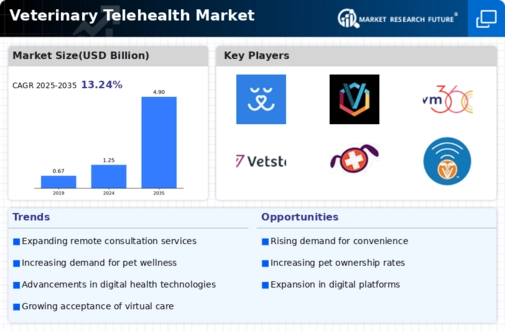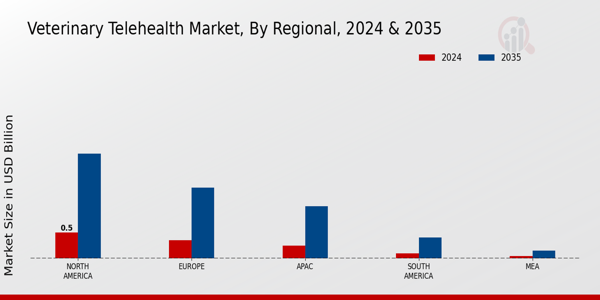Rising Pet Ownership
The Veterinary Telehealth Market appears to be experiencing a surge in demand, driven by the increasing rates of pet ownership. As more households welcome pets, the need for accessible veterinary care becomes paramount. In recent years, pet ownership has risen significantly, with estimates suggesting that over 67 percent of households own a pet. This trend indicates a growing market for veterinary services, including telehealth options. Pet owners are increasingly seeking convenient solutions for their pets' health needs, which telehealth services can provide. The Veterinary Telehealth Market is likely to benefit from this trend, as it offers a flexible and efficient way for pet owners to consult with veterinarians without the need for in-person visits. This shift towards telehealth could potentially reshape the landscape of veterinary care, making it more accessible and responsive to the needs of pet owners.
Increased Focus on Convenience
Convenience is a driving force behind the growth of the Veterinary Telehealth Market. Pet owners are increasingly looking for ways to simplify their lives, and telehealth services offer a practical solution. The ability to consult with a veterinarian from the comfort of home eliminates the need for travel and waiting times, which can be particularly beneficial for busy pet owners. This trend aligns with broader consumer preferences for on-demand services across various sectors. As the Veterinary Telehealth Market continues to evolve, the emphasis on convenience is likely to attract more pet owners to telehealth options. The potential for 24/7 access to veterinary care through telehealth platforms may further enhance this appeal, allowing pet owners to seek advice and treatment at their convenience. This shift towards convenience could significantly influence the adoption rates of telehealth services in veterinary care.
Cost-Effectiveness of Telehealth Services
Cost considerations play a crucial role in the Veterinary Telehealth Market. Telehealth services often present a more affordable alternative to traditional veterinary visits, which can be a significant factor for pet owners. The average cost of a veterinary visit can range from $50 to $250, depending on the services required. In contrast, telehealth consultations typically cost less, making them an attractive option for budget-conscious pet owners. This cost-effectiveness is particularly appealing in a market where pet healthcare expenses are on the rise. As pet owners seek ways to manage their budgets while ensuring their pets receive quality care, the Veterinary Telehealth Market is likely to see increased adoption of telehealth services. This trend suggests that cost savings could drive the growth of telehealth solutions in veterinary care, making it a viable option for a broader audience.
Regulatory Support for Telehealth Services
Regulatory frameworks are evolving to support the Veterinary Telehealth Market, which may facilitate its growth. Governments and veterinary boards are increasingly recognizing the importance of telehealth in providing accessible veterinary care. Recent policy changes have aimed to streamline the licensing and practice regulations for telehealth services, making it easier for veterinarians to offer remote consultations. This regulatory support is crucial in legitimizing telehealth as a viable option for pet care. As these frameworks become more established, the Veterinary Telehealth Market is likely to see an influx of new providers entering the market, enhancing competition and service offerings. Furthermore, the alignment of regulatory policies with technological advancements may create a conducive environment for the expansion of telehealth services in veterinary care. This supportive landscape could significantly influence the future trajectory of the Veterinary Telehealth Market.
Technological Integration in Veterinary Practices
The integration of advanced technology into veterinary practices is a notable driver of the Veterinary Telehealth Market. Innovations such as mobile applications, video conferencing tools, and artificial intelligence are transforming how veterinary care is delivered. These technologies facilitate real-time consultations and enable veterinarians to monitor pets remotely, enhancing the overall quality of care. The Veterinary Telehealth Market is likely to benefit from these advancements, as they improve the efficiency and effectiveness of telehealth services. Moreover, the increasing familiarity of pet owners with technology suggests a growing acceptance of telehealth solutions. As veterinary practices adopt these technologies, the potential for improved patient outcomes and enhanced client satisfaction may drive further growth in the telehealth sector. This technological evolution could redefine the standards of veterinary care, making telehealth an integral part of the veterinary landscape.


















Leave a Comment